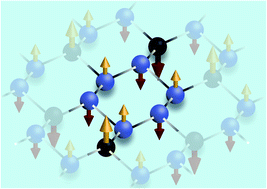Antiferromagnetic spin ordering in two-dimensional honeycomb lattice of SiP3†
Abstract
Magnetism in low-dimensional materials has been of sustained interest due to its intriguing quantum mechanical origin and promising device applications. Here, we propose a buckled honeycomb lattice of stoichiometry SiP3, a two-dimensional binary group-IV and V material that exhibits an antiferromagnetic ground state with itinerant electrons. Here we perform elemental Si substitution in pristine blue phosphorene to downshift the Fermi energy and induce the Fermi instability that results in a spin polarized ground state. Within first-principles calculations, we observe antiferromagnetic spin alignment between adjacent ferromagnetic triangular domains where each Si atom is coupled with three neighboring P atoms with a ferromagnetic interaction. Such unique spin structure and resulting magnetic ground state are unprecedented in defect-free two-dimensional materials made of only p-block elements. This metal-free magnetism can be exploited for advanced spintronic and memory storage applications.



 Please wait while we load your content...
Please wait while we load your content...